电子线路测试实验
汽车尾灯控制电路 FPGA 代码及仿真答案
华中科技大学电信系
作者:华中科技大学 释梵
声明:
本答案出于学习交流之用,不可用于商业用途。
Windows 7 Sins: The case against Microsoft and proprietary software
The new version of Microsoft's Windows operating system, Windows 7, has the same problem that
Vista, XP, and all previous versions have had -- it's proprietary software. Users are not permitted to
share or modify the Windows software, or examine how it works inside.
The fact that Windows 7 is proprietary means that Microsoft asserts legal control over its users
through a combination of copyrights, contracts, and patents. Microsoft uses this power to abuse
computer users. At windows7sins.org, the Free Software Foundation lists seven examples of abuse
committed by Microsoft.
We've mailed a letter to 499 of the
Fortune 500 companies (we didn't
think Microsoft would listen), but
that's just the start...
1. Poisoning education: Today, most children whose
education involves computers are being taught to use one
company's product: Microsoft's. Microsoft spends large
sums on lobbyists and marketing to corrupt educational
departments. An education using the power of computers
should be a means to freedom and empowerment, not an
avenue for one corporation to instill its monopoly.
2. Invading privacy: Microsoft uses software with
backward names like Windows Genuine Advantage to
inspect the contents of users' hard drives. The licensing
agreement users are required to accept before using
Windows warns that Microsoft claims the right to do this
without warning.
3. Monopoly behavior: Nearly every computer
purchased has Windows pre-installed -- but not by
choice. Microsoft dictates requirements to hardware
vendors, who will not offer PCs without Windows
installed on them, despite many people asking for them.
Even computers available with other operating systems
like GNU/Linux pre-installed often had Windows on
them first.
We've also mailed another letter to
500 non-profit groups around the
world.
We'd love to send more letters to the
Windows 7 decision makers that
people have identified within their own
organization or community, and with
your help we can.
If you donate $25 dollars, we'll send 50
more letters, donate $100 we'll send
200 letters and so on.
Send us your suggestions for
organizations who would benefit from
our letter.
4. Lock-in: Microsoft regularly attempts to force updates on its users, by removing support for
older versions of Windows and Office, and by inflating hardware requirements. For many people,
this means having to throw away working computers just because they don't meet the unnecessary
�
requirements for the new Windows versions.
5. Abusing standards: Microsoft has attempted to block free standardization of document formats,
because standards like OpenDocument Format would threaten the control they have now over users
via proprietary Word formats. They have engaged in underhanded behavior, including bribing
officials, in an attempt to stop such efforts.
6. Enforcing Digital Restrictions Management (DRM): With Windows Media Player, Microsoft
works in collusion with the big media companies to build restrictions on copying and playing media
into their operating system. For example, at the request of NBC, Microsoft was able to prevent
Windows users from recording television shows that they have the legal right to record.
7. Threatening user security: Windows has a long history of security vulnerabilities, enabling the
spread of viruses and allowing remote users to take over people's computers for use in spam-
sending botnets. Because the software is secret, all users are dependent on Microsoft to fix these
problems -- but Microsoft has its own security interests at heart, not those of its users.
http://en.windows7sins.org/
汽车驾驶室一般有刹车开关、左转弯开关和右转弯开关,司机通过操作这三个开关控制着汽
车尾灯的显示状态,以表明汽车当前的行驶状态。假设汽车尾部左、右两侧各有 3 个指示灯
(用发光二极管模拟),要求设计一个电路能实现如下功能。
1、汽车正常行驶时,尾部两侧的 6 个指示灯全灭灯。
操作方式:stop=0,left=0,right=0,reverse=0
2、刹车时,尾部两侧的灯全亮
操作方式:reverse=0,stop=1,left=0,right=0
3、右转弯时,右侧 3 个指示灯为右顺序循环点亮,频率为 1Hz,左侧灯全灭。
操作方式:reverse=0,stop=0,right=1,left=0
�
4、左转弯时,左侧 3 个指示灯为左顺序循环点亮,频率为 1Hz,右侧灯全灭。
操作方式:reverse=0,stop=0,right=0,left=1
5、右转弯刹车时,右侧的三个尾灯顺序循环点亮,左侧的灯全亮;左转弯刹车时,左侧的
三个尾部灯顺序循环点亮,右侧的灯全亮。
操作方式:reverse=0,stop=1,right=1,left=0;reverse=0,stop=1,right=0,left=1
�
6、倒车时,尾部两侧的 6 个指示灯随 CP 时钟脉冲同步闪烁。
操作方式:reverse=1
代码:
/////////reverseLight.v
module reverseLight(leftThree,rightThree,CP);
output [2:0] leftThree,rightThree;
input CP;
reg[2:0] leftThree,rightThree;
always@(posedge CP)
begin
end
{leftThree,rightThree}<=~{leftThree,rightThree};
endmodule
////////////shutDown.v
module shutDown(leftThree,rightThree,CP);
output [2:0] leftThree,rightThree;
input CP;
reg[2:0] leftThree,rightThree;
always@(posedge CP)
begin
{leftThree,rightThree}<=6'b000000;
end
endmodule
///////////shutLeft.v
module shutLeft(leftThree,rightThree,CP);
output [2:0] leftThree,rightThree;
input CP;
reg[2:0] leftThree,rightThree;
integer i;
always@(posedge CP)
begin
rightThree[0]<=1'b1;
�
rightThree[1]<=1'b1;
rightThree[2]<=1'b1;
i=i+1;
if(i==3)
i=0;
if(i==0)
leftThree<=3'b001;
else if(i==1)
else if(i==2)
leftThree<=3'b010;
leftThree<=3'b100;
end
endmodule
///////////////shutRight.v
module shutRight(leftThree,rightThree,CP);
output [2:0] leftThree,rightThree;
input CP;
reg[2:0] leftThree,rightThree;
integer i;
always@(posedge CP)
begin
leftThree[0]<=1'b1;
leftThree[1]<=1'b1;
leftThree[2]<=1'b1;
i=i+1;
if(i==3)
i=0;
if(i==0)
rightThree<=3'b001;
else if(i==1)
else if(i==2)
rightThree<=3'b010;
rightThree<=3'b100;
end
endmodule
//////////////////tailLight.v
module tailLight(leftThree,rightThree,CP,stop,left,right,reverse,test);
output [2:0] leftThree,rightThree,test;
input CP,stop,left,right,reverse;
wire [2:0] leftThree,rightThree,test;
wire
reverseLightCP,shutDownCP,shutLeftCP,shutRightCP,subTemplateCP,tailLightCP,turnLeftCP,tur
nOnCP,turnRightCP;
wire [2:0] leftThree0,rightThree0,
�
leftThree6,rightThree6,leftThree5,rightThree5,leftThree2,rightThree2,leftThree4,rightThree4,leftTh
ree1,rightThree1,leftThreex,rightThreex;
assign test=rightThree5[1];
assign leftThree[0]=(reverse&&leftThreex[0])||((~stop)&&(~left)&&(~right)&&leftThree0[0])||
(stop&&left&&(~right)&&leftThree6[0])||(stop&&(~left)&&right&&leftThree5[0])||
((~stop)&&left&&(~right)&&leftThree2[0])||(stop&&(~left)&&(~right)&&leftThree4[0])||
((~stop)&&(~left)&&right&&leftThree1[0]);
assign leftThree[1]=(reverse&&leftThreex[1])||((~stop)&&(~left)&&(~right)&&leftThree1[1])||
(stop&&left&&(~right)&&leftThree6[1])||(stop&&(~left)&&right&&leftThree5[1])||
((~stop)&&left&&(~right)&&leftThree2[1])||(stop&&(~left)&&(~right)&&leftThree4[1])||
((~stop)&&(~left)&&right&&leftThree1[1]);
assign leftThree[2]=(reverse&&leftThreex[2])||((~stop)&&(~left)&&(~right)&&leftThree2[2])||
(stop&&left&&(~right)&&leftThree6[2])||(stop&&(~left)&&right&&leftThree5[2])||
((~stop)&&left&&(~right)&&leftThree2[2])||(stop&&(~left)&&(~right)&&leftThree4[2])||
((~stop)&&(~left)&&right&&leftThree1[2]);
assign rightThree[0]=(reverse&&rightThreex[0])||
((~stop)&&(~left)&&(~right)&&rightThree0[0])||(stop&&left&&(~right)&&rightThree6[0])||
(stop&&(~left)&&right&&rightThree5[0])||((~stop)&&left&&(~right)&&rightThree2[0])||
(stop&&(~left)&&(~right)&&rightThree4[0])||((~stop)&&(~left)&&right&&rightThree1[0]);
assign rightThree[1]=(reverse&&rightThreex[1])||
((~stop)&&(~left)&&(~right)&&rightThree1[1])||(stop&&left&&(~right)&&rightThree6[1])||
(stop&&(~left)&&right&&rightThree5[1])||((~stop)&&left&&(~right)&&rightThree2[1])||
(stop&&(~left)&&(~right)&&rightThree4[1])||((~stop)&&(~left)&&right&&rightThree1[1]);
assign rightThree[2]=(reverse&&rightThreex[2])||
((~stop)&&(~left)&&(~right)&&rightThree2[2])||(stop&&left&&(~right)&&rightThree6[2])||
(stop&&(~left)&&right&&rightThree5[2])||((~stop)&&left&&(~right)&&rightThree2[2])||
(stop&&(~left)&&(~right)&&rightThree4[2])||((~stop)&&(~left)&&right&&rightThree1[2]);
assign reverseLightCP=reverse&&CP;
reverseLight Ux(leftThreex,rightThreex,reverseLightCP);
assign shutDownCP=(~stop)&&(~left)&&(~right)&&CP;
shutDown U0(leftThree0,rightThree0,shutDownCP);
assign shutLeftCP=stop&&left&&(~right)&&CP;
shutLeft U6(leftThree6,rightThree6,shutLeftCP);
assign shutRightCP=stop&&(~left)&&right&&CP;
shutRight U5(leftThree5,rightThree5,shutRightCP);
assign turnLeftCP=(~stop)&&left&&(~right)&&CP;
turnLeft U2(leftThree2,rightThree2,turnLeftCP);
assign turnOnCP=stop&&(~left)&&(~right)&&CP;
turnOn U4(leftThree4,rightThree4,turnOnCP);
�
assign turnRightCP=(~stop)&&(~left)&&right&&CP;
turnRight U1(leftThree1,rightThree1,turnRightCP);
endmodule
////////////turnLeft.v
module turnLeft(leftThree,rightThree,CP);
output [2:0] leftThree,rightThree;
input CP;
reg[2:0] leftThree,rightThree;
integer i;
always@(posedge CP)
begin
rightThree[0]<=1'b0;
rightThree[1]<=1'b0;
rightThree[2]<=1'b0;
i=i+1;
if(i==3)
i=0;
if(i==0)
leftThree<=3'b001;
else if(i==1)
else if(i==2)
leftThree<=3'b010;
leftThree<=3'b100;
end
endmodule
///////////turnRight.v
module turnRight(leftThree,rightThree,CP);
output [2:0] leftThree,rightThree;
input CP;
reg[2:0] leftThree,rightThree;
integer i;
always@(posedge CP)
begin
leftThree[0]<=1'b0;
leftThree[1]<=1'b0;
leftThree[2]<=1'b0;
i=i+1;
if(i==3)
i=0;
if(i==0)
rightThree<=3'b001;
else if(i==1)
�
rightThree<=3'b010;
else if(i==2)
rightThree<=3'b100;
end
endmodule
////////////turnOn.v
module turnOn(leftThree,rightThree,CP);
output [2:0] leftThree,rightThree;
input CP;
reg[2:0] leftThree,rightThree;
always@(posedge CP)
begin
{leftThree,rightThree}<=6'b111111;
end
endmodule
�
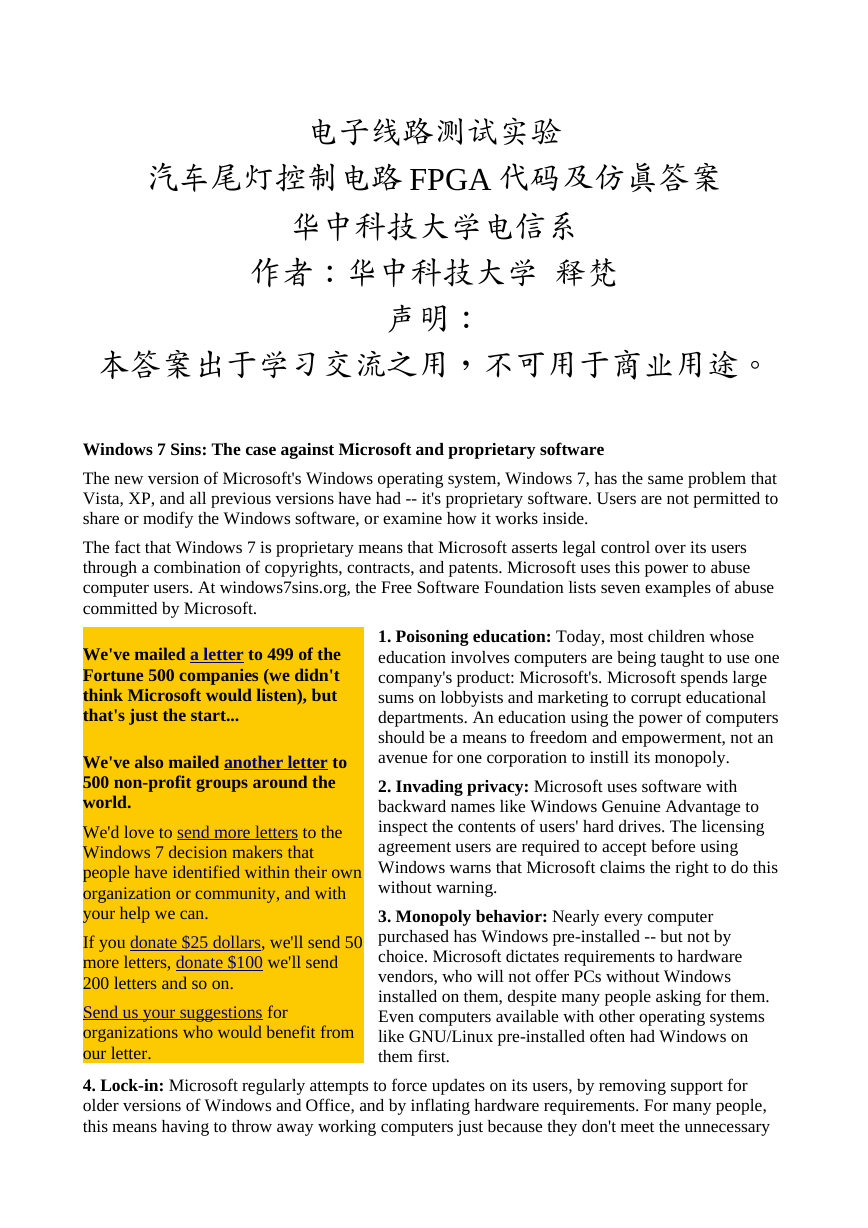
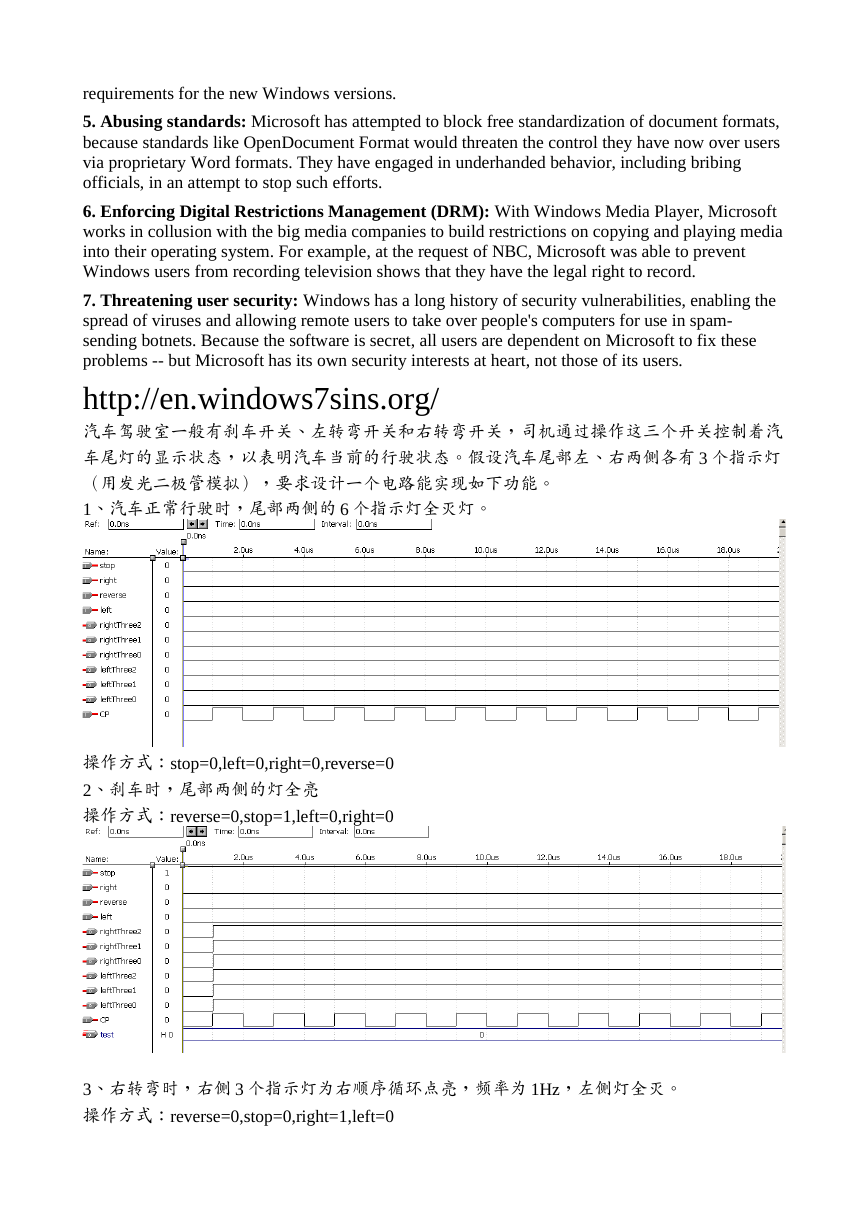
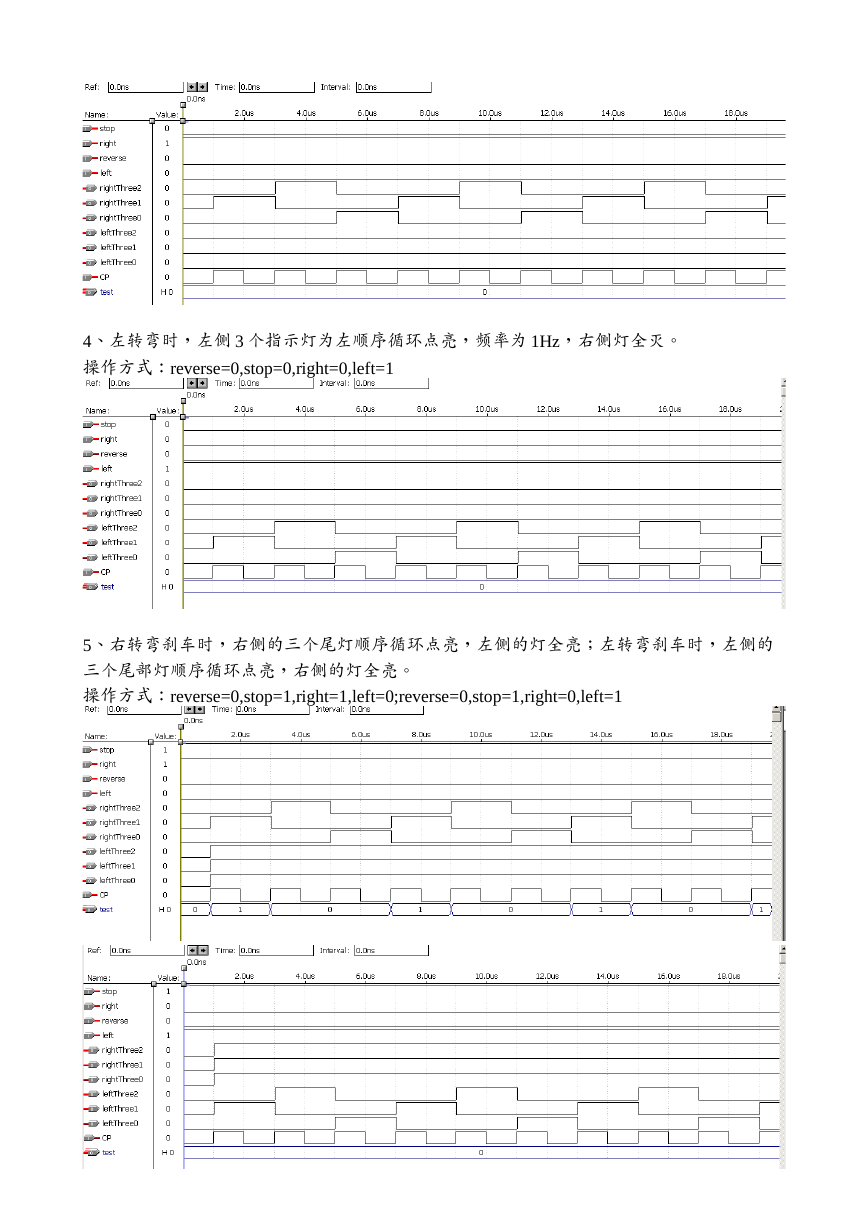
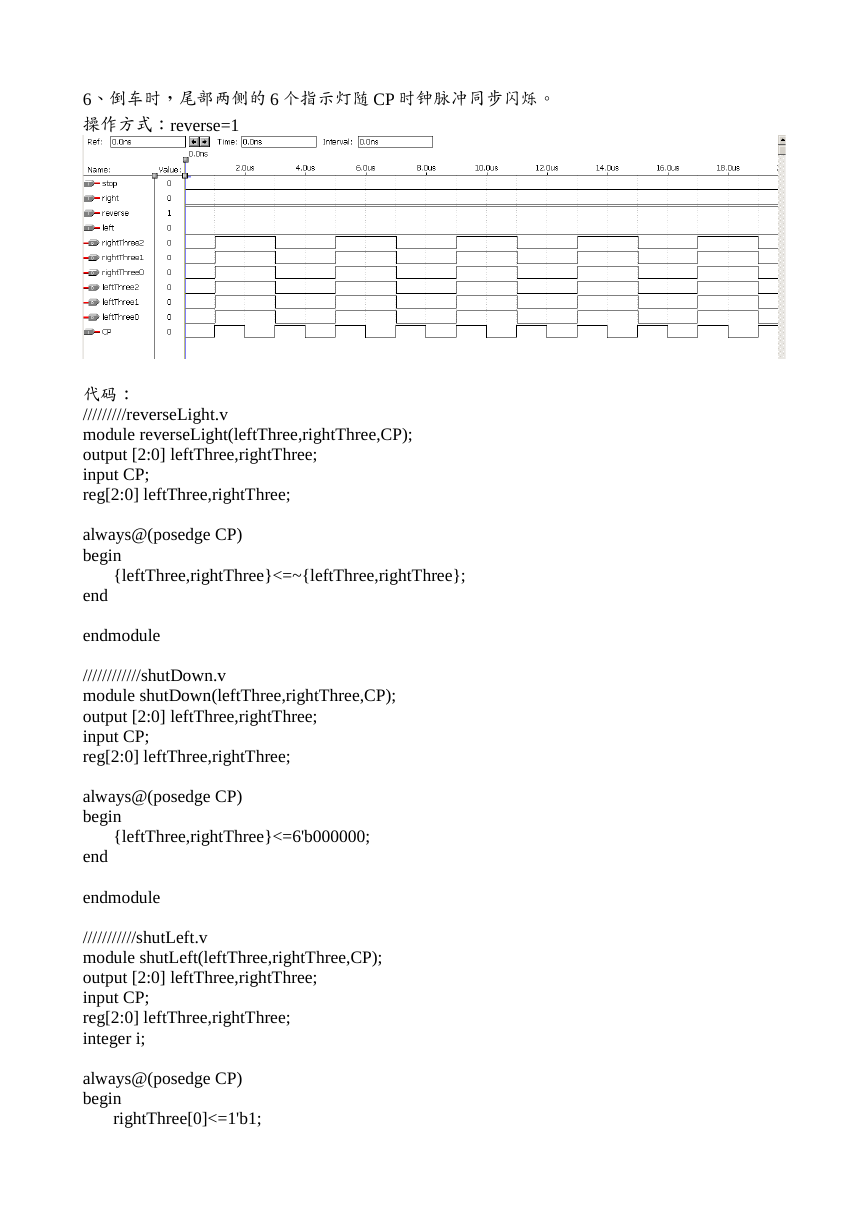
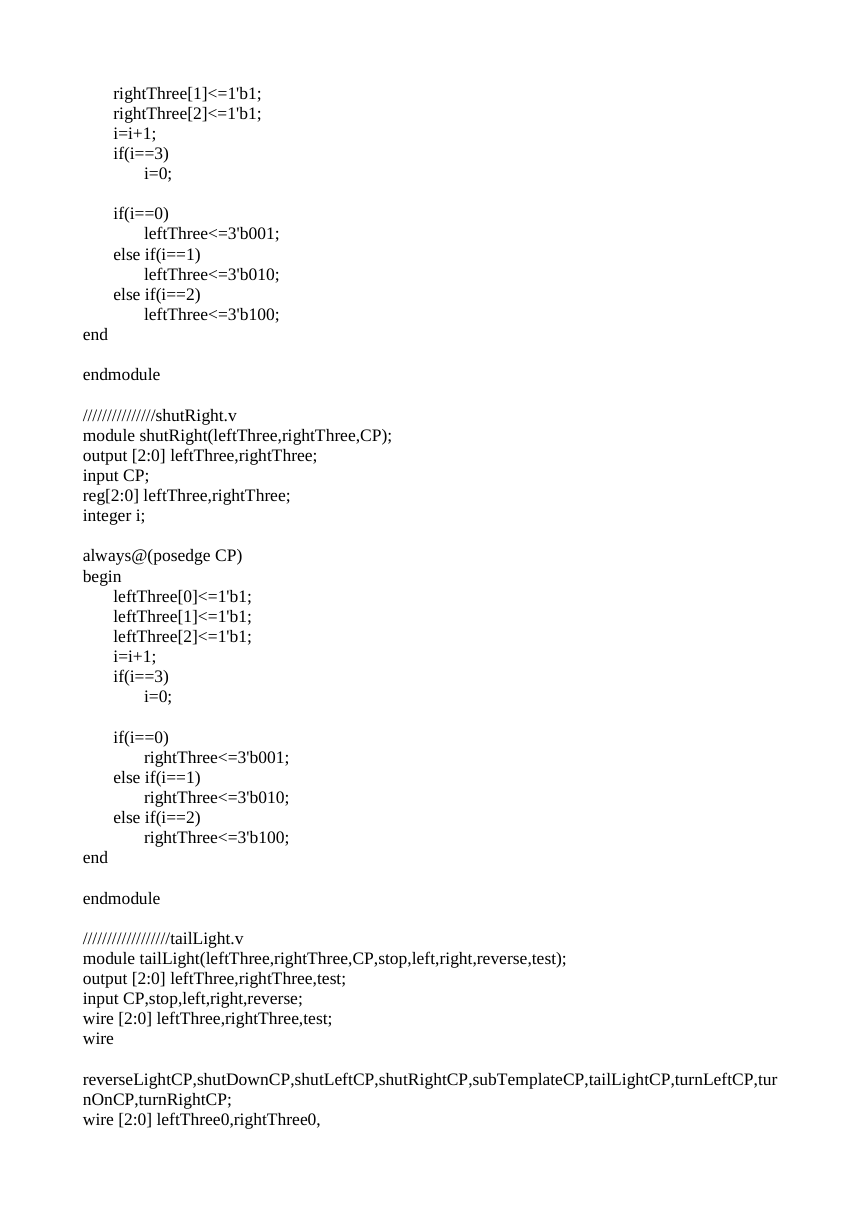
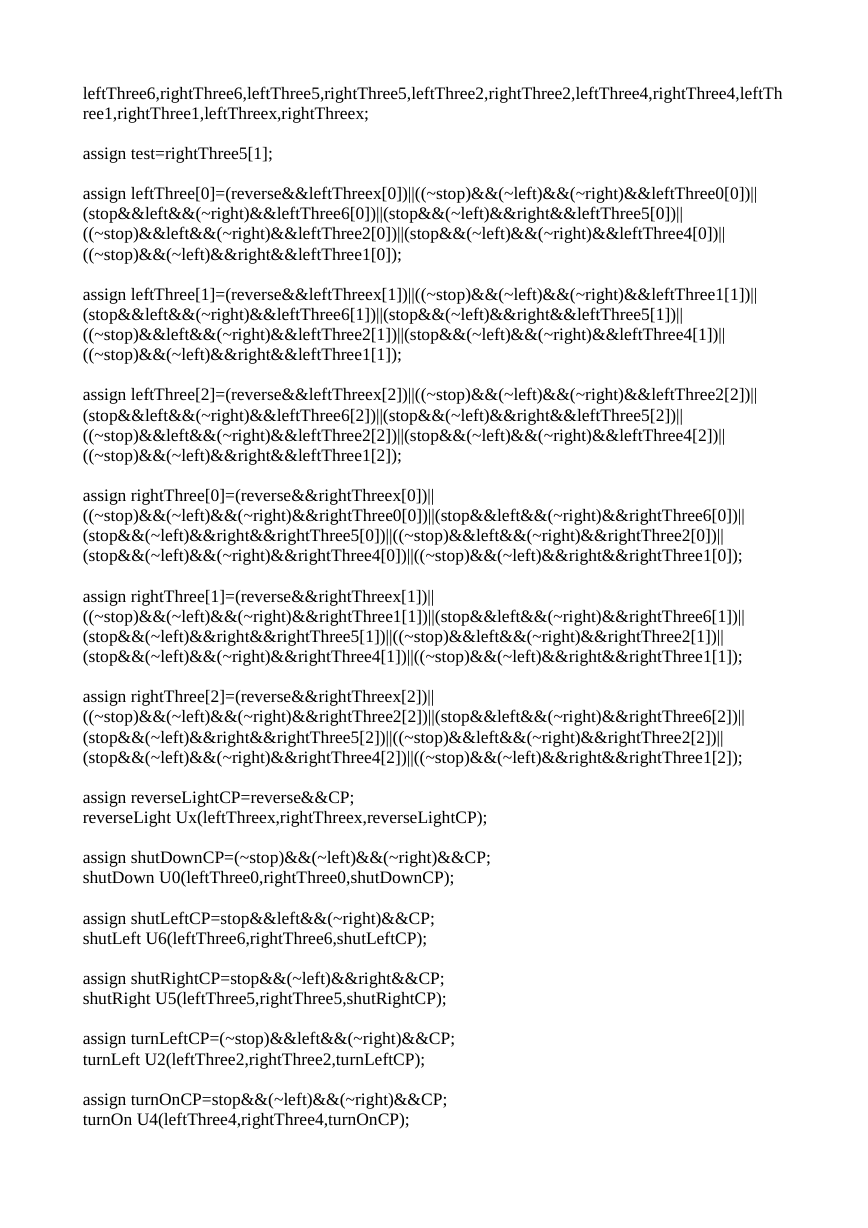
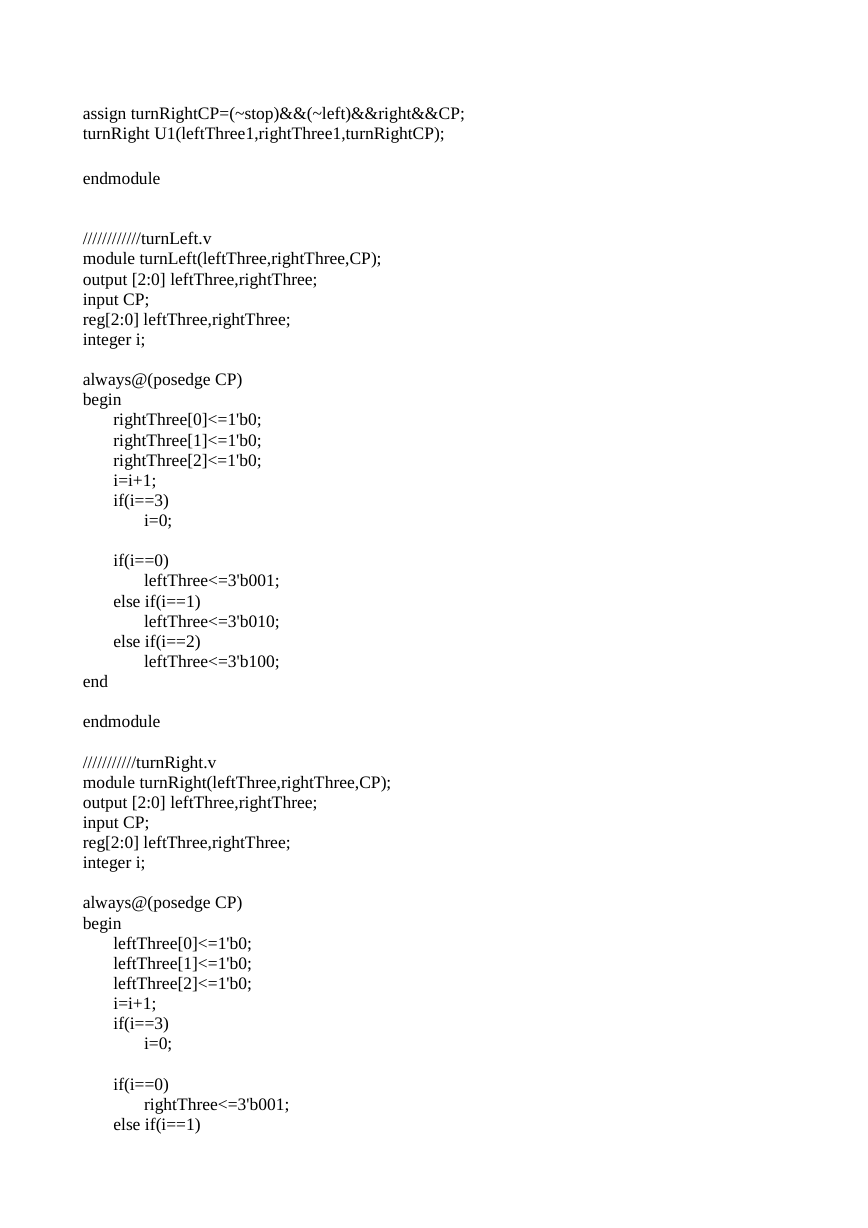
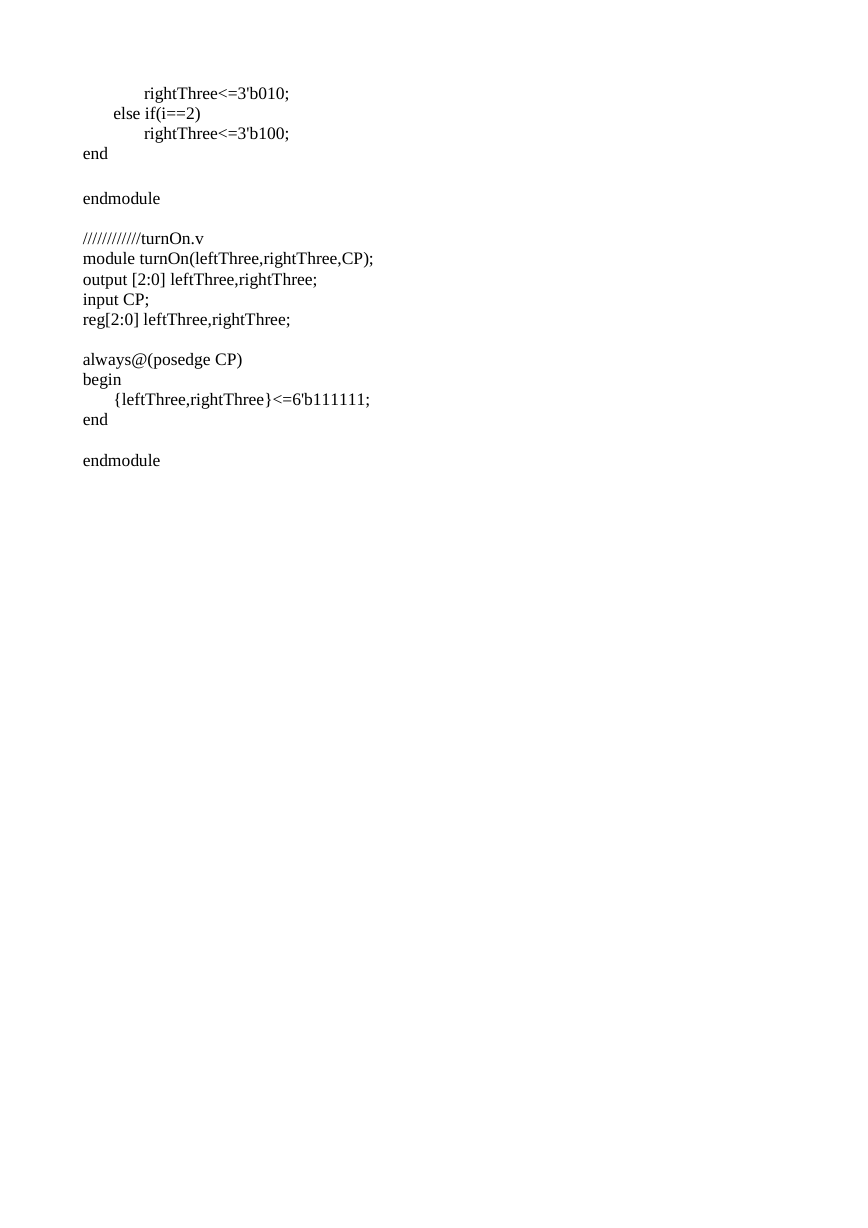








 2023年江西萍乡中考道德与法治真题及答案.doc
2023年江西萍乡中考道德与法治真题及答案.doc 2012年重庆南川中考生物真题及答案.doc
2012年重庆南川中考生物真题及答案.doc 2013年江西师范大学地理学综合及文艺理论基础考研真题.doc
2013年江西师范大学地理学综合及文艺理论基础考研真题.doc 2020年四川甘孜小升初语文真题及答案I卷.doc
2020年四川甘孜小升初语文真题及答案I卷.doc 2020年注册岩土工程师专业基础考试真题及答案.doc
2020年注册岩土工程师专业基础考试真题及答案.doc 2023-2024学年福建省厦门市九年级上学期数学月考试题及答案.doc
2023-2024学年福建省厦门市九年级上学期数学月考试题及答案.doc 2021-2022学年辽宁省沈阳市大东区九年级上学期语文期末试题及答案.doc
2021-2022学年辽宁省沈阳市大东区九年级上学期语文期末试题及答案.doc 2022-2023学年北京东城区初三第一学期物理期末试卷及答案.doc
2022-2023学年北京东城区初三第一学期物理期末试卷及答案.doc 2018上半年江西教师资格初中地理学科知识与教学能力真题及答案.doc
2018上半年江西教师资格初中地理学科知识与教学能力真题及答案.doc 2012年河北国家公务员申论考试真题及答案-省级.doc
2012年河北国家公务员申论考试真题及答案-省级.doc 2020-2021学年江苏省扬州市江都区邵樊片九年级上学期数学第一次质量检测试题及答案.doc
2020-2021学年江苏省扬州市江都区邵樊片九年级上学期数学第一次质量检测试题及答案.doc 2022下半年黑龙江教师资格证中学综合素质真题及答案.doc
2022下半年黑龙江教师资格证中学综合素质真题及答案.doc